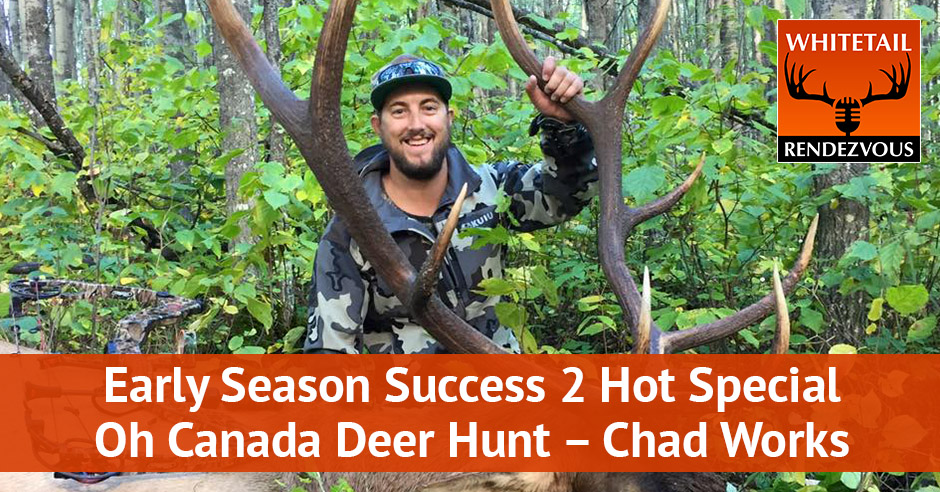
Listen to the podcast here:
Early Season Success 2 Hot Special Oh Canada Deer Hunt – Chad Works
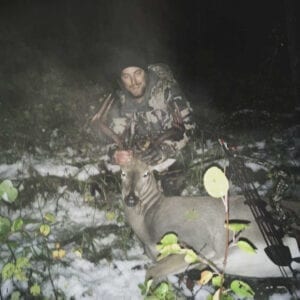 We’re heading north of the border and a friend of mine, Chad Works, a social media friend. Chad works up in Alberta, Drayton Valley, just north of Edmonton. He took a dandy buck. I said, “Let’s get this on Early Season bucks.” Chad, first of all, welcome. It’s lovely to have you. Let’s jump right into it and talk about this early season buck with snow on the ground from O Canada.
We’re heading north of the border and a friend of mine, Chad Works, a social media friend. Chad works up in Alberta, Drayton Valley, just north of Edmonton. He took a dandy buck. I said, “Let’s get this on Early Season bucks.” Chad, first of all, welcome. It’s lovely to have you. Let’s jump right into it and talk about this early season buck with snow on the ground from O Canada.
Thanks for having me.
Tell the story.
It was like any other day. I was hunting down south for mule deer and I decided to end that trip pretty early, so I came back and it was pretty wet, snowy and everything else. The wind wasn’t in my favor, but I decided to go sit in my stand. I never had this buck on game camera and a week before that, I had a grizzly bear go through my area where I was hunting. I thought, “There’s no way a buck is going to come out,” but I thought I better go have a quick peep. I sat in the stand for maybe 40 minutes and this guy comes out twenty yards from me. He was a good deer. I had never seen him before. He had nice dark antlers and they were a tinge or red from the velvet coming off them. I was pretty excited. He decided to walk down the trail and come out ten yards in front of me and he was nervous and everything else and gave me an opportunity and I let him have it.
That’s a good story, but how come your stand was there? Let’s get the backstory. You said you never saw him, so you got cameras out?
I did pre-scouting. I usually get my cameras out. I try to get my cameras out mid-July, even June or even the end of June. I like to see the start of the growth of the antlers. I love just being out in the woods and setting stands in the right areas. I got a good spot where it’s between a big field and a lot of bedding areas. I did a lot of pre-scouting in that area to be able to get an opportunity to harvest a good deer in that area. I usually have lots of pictures of decent bucks walking through, but nothing of this caliber. Maybe a little bit bigger, too, but it’s always different.
Do pre-scouting in an area to be able to get an opportunity to harvest a good deer. Share on XIs it a funnel? Is it a pinch point? How would you describe it?
No, it would be more or less of a funnel coming right through from their bedding area all the way to the food out in the farmer’s field out there. He’s got canola out there this year and they love grazing through that stuff and chomping away on it. I try to cut them off before they head out to their food or to their bed.
Can you catch them going in that night or coming back in the morning?
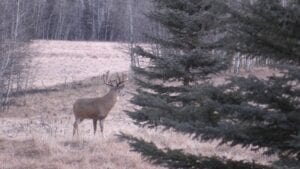 I’m on a very heavy intersection. Deer are heading into bed and cruising around or whatever else. It’s a very busy spot.
I’m on a very heavy intersection. Deer are heading into bed and cruising around or whatever else. It’s a very busy spot.
When you don’t see mature bucks, how do you change it up? Do you just take what comes?
I have a few other stands, too, that I have up in areas closer to that one. I try to keep my options open. I play the wind, that’s a big factor that I’ve learned over the years is playing the wind in a different stand location to try to track these deer down. I’ve had a few decent bucks in that area. This deer was not on my game camera. I was really excited when he came out because it had a nice mass and everything to him. I had a nice deer in there, but when a grizzly bear walks through, it messes up the equations that you’ve been working on over the whole summers to try to land it.
Why is that? Is the grizzly bear after fawns or he just disrupts everything?
He disrupts everything. It’s no different, like we have a lot of cougars, too, and everything else. Once they get in there, it seems like everything, the deer, the elk, just vanishes. That spot there, I have a game camera set up all through the year almost because it’s one of my favorite spots to hunt. I’ve watched a lot of big bucks come in and out of there. All of a sudden it seems like every year I run into something, whether it’s a cougar passing through or it was a grizzly bear. Everybody says there are no grizzly bears in Alberta, but they’re all over the place.
There’s a lot of bears throughout. Not just black bears.
They put a real damper on things because everything gets scared of them because they’re not afraid to take down a fawn or anything else.
What about your wolf population?
Wolf is very strong, more west of my location of hunting. I haven’t had any on a game camera. I have seen them out in the wild, but never really interrupted my hunting. It’s literally more or less a lot of cougars. I’ve had a lot of cougar around my house, all my hunting quarters. I think every quarter I’ve hunted on so far of land has had a cougar pass through it at some point or time. This is the first for me for having a grizzly pass through, which is cool, but when I was tracking that deer at night, it was nerve-wracking. Try to get in there, get that deer out as fast as you possibly can, but at the same time you want to leave that deer and let him die in peace.
This is the first conversation where grizzlies have come into the equation for whitetails that I’ve had. I don’t know how big their range is. I know cats can run 100 miles. One cat can run a 100-mile loop. Every seven days they’re killing a deer. I hunt mule deer here in Colorado. That’s pretty standard, that’s what they do. They feed on it until it’s gone, and then they keep moving. Their home range is really large, so I’m familiar with that. As far as with grizzlies, I have to carry my Mossberg 500 just in case with slugs in it. It’s bad enough in Wisconsin where I hunt having the wolves go off because they’re around. I carry a nine just because of that. Walking out, or if you do hit a deer late in the day and you’ve got to wait a while, it almost attracts meat.
That’s where I really wish that in Alberta or Canada at that we were able to, as hunters, especially bow hunters. You’re going in there with an arrow nocked. If a bear, a grizzly, especially black bear, you can clap your hands and they’re going to run away. A grizzly, if it’s a mom with cubs, you could really stir a pot with that. If you were able to carry a handgun, or something at least, and be able to fire away if it comes at you, they’re so strict on that. If you ever killed a grizzly bear, you’d better have some scratches on your face.
I get that, but everybody has got to decide how they’re going to protect themselves if it becomes an issue. In the end, you could be mauled or dead and it sure is not worth it.
Way back in the bush, there is the main road not too far from me, but I don’t tell everybody I’m going in to check my camera. If I go in and check my camera, that could be it. The chances of grizzlies, like they are more or less a passerby, unless there are good food and good comfort for them to stick around for some strange reason. You just never know. That’s why it is nice. When I was checking my cameras, I did take my .270 in with me just because there’s a nice comfort for me.
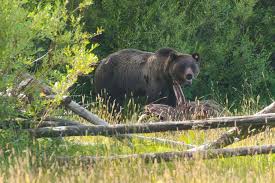 Let’s talk about your hunting area. We know you were successful and such, but let’s talk about the area, so your agriculture and bush. There’s a lot of edge cover for whitetails. Take us through the area that you hunt, how big it is, and how you set it up.
Let’s talk about your hunting area. We know you were successful and such, but let’s talk about the area, so your agriculture and bush. There’s a lot of edge cover for whitetails. Take us through the area that you hunt, how big it is, and how you set it up.
Honestly, I do a lot on Google Maps, and I do it so that I can see the layout of the land and everything. That gives you a pretty good idea of what it will be, other than a little bit of growth and stuff over the last few years maybe. I do a lot of pre-scouting where I drive around and I look in fields. I see what deer are moving across the road, everything else, and where the good food is and what farmers are doing what each year. When I went and chose this land, it is only a quarter section of land, which is only 160 acres of land. It is a lot of fields, but it’s a cattle grazing field. He didn’t have his cows in this year, thankfully. I got maybe 60 acres of bush, a straight line of the bush. I chose a spot in there which was a heavy intersection, lots of deer tracks, scrapes everywhere, elk scrapes everywhere.
I knew there was a good possibility, so I slapped a camera up there and it worked out for me. I have lots of elk passing through there. I shot a big 5×5 in there. Out of that same stand, I shot a 5×5 bull elk and I shot a 4×4 eight-point buck out of the same stand within 22 days apart. I got lucky enough where I shot another really nice deer, a 140-inch roughly deer. It’s a really good spot. It seems like I tried to read it. I tried to read where the food is, where they could pass through an open field. I love the bush cover. I love that they can go from almost four quarters of land straight through the bush and never see a field or anything and I’m right in the middle of it all. I do get a lot of passerby bucks. If you spend the time in your stand, you could have the possibility of shooting any one of them bucks ever.
Everybody says there are no grizzly bears in Alberta, but they’re all over the place. Share on XDo you have hang-ons, ladder stands or ground blinds? What’s your setup?
That’s the first stand I bought when I moved to Alberta. It was a ladder stand. It was a single-man ladder stand. I put it up right at the intersection and it’s got a bunch of alder bushes surrounding it so they can’t see the ladder. I put it up in June. I gave it about two months roughly of the deer getting used to it. Once they got used to it, they have no idea, they don’t care anymore that it’s there. It’s been up for years.
You mentioned elk. What type of terrain are you in? Is it hilly terrain? It’s not mountainous at all north of Edmonton.
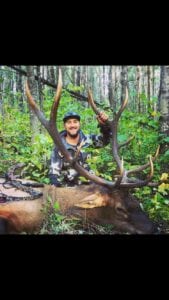 There are a few hills around, but it’s nothing crazy. They just love the bush and they love being around the river, as far as what I’ve seen over the last few years of hunting them. I spent the first couple of years trying to learn them, trying to speak their language, as per se. I use the Primos elk reeds and I love it. I love elk hunting. I love everything there is about it. I spent a couple of years just trying to learn about them before I even went after them because I didn’t want to spook any out of my area. Even when I knew I had elk in there, I was hoping maybe I’d get lucky if one passed by, but I would never try to call them. I didn’t want to scare anything. It’s pretty much flat terrain, lots of trees, lots of cover for them. There is food all around my quarter. My area is a good spot for bedding, whether it’s to the west or east of me.
There are a few hills around, but it’s nothing crazy. They just love the bush and they love being around the river, as far as what I’ve seen over the last few years of hunting them. I spent the first couple of years trying to learn them, trying to speak their language, as per se. I use the Primos elk reeds and I love it. I love elk hunting. I love everything there is about it. I spent a couple of years just trying to learn about them before I even went after them because I didn’t want to spook any out of my area. Even when I knew I had elk in there, I was hoping maybe I’d get lucky if one passed by, but I would never try to call them. I didn’t want to scare anything. It’s pretty much flat terrain, lots of trees, lots of cover for them. There is food all around my quarter. My area is a good spot for bedding, whether it’s to the west or east of me.
You mentioned a river. Is it a major river or is it just a creek?
It’s a pretty big river called the Pembina River. It flows through Drayton and everywhere else. It’s not a fast river. I just know in the area that I’m in that roughly mid-October, late October, November, the start of it, they’re guaranteed they’re pushed back down to the river. It seems like every year they love to head back to the river and that’s where they hang out the rest of the year. A lot of my areas that I do hunt, bow season is top notch for elk season. The last few years I’ve been hunting elk hard, and I hunt elk extremely hard in all these parts. That’s all I do. I half don’t even worry about whitetail because I want to get an elk down. I love meat. It feeds my family for a full year.
Are you spot-and-stalking or are you just calling?
I’m calling them in. I’ll walk into a bush in a nice area if I know the quarter well. I’ll know where the elk are roughly traveling through or where they’ll pop out or where they’re going to be roughly. You can’t ever be 100% sure, but I use the mouth reeds, the mouth diaphragms. I do cow calls and bugles and different stuff and just wait for them to respond, and hopefully they’re in the area.
Elk hunting in your country is a lot like whitetail hunting. It’s very similar because, one, food, shelter, and water. That’s what whitetails need, the same thing. Elk are just bigger. They make more noise and they’re quite vocal at the right time of year. Elk hunting, like you’re doing, that sounds pretty exciting. As opposed to in the Rockies, you get high in basins and stuff like that. I’m not talking about hunting elk in the oak brush, which would be comparable to the bush, but get 10,000 feet or above, that’s where I like to hunt elk is in the alpine.
That is one of my main goals is to head up into the mountains and hunt them right on flatlands right below the belly of the beast thing. I’d love to follow them and track them around up there, but I’ve been having so much good luck around my area, staying in the lowlands and in the trees and everything else. To me, they’re nothing like a deer. You never see them out in the fields unless you’re up at 5:00 in the morning and you can catch a glimpse of them going into the shelter before daylight cracks, because that’s their favorite time. They feed all night, they’re out all night, and they head to bed first thing in the morning. That’s the best time to call. That’s my favorite time to call is go in and do a couple of nice soft cow calls, and then have a big old raspy bull scream back at you.
That is fun no matter what terrain or what habitat you’re in. You get one of those bulls going and it’s exciting. Talk to me about how you use vocalization for hunting whitetails.
I usually don’t push them on the whitetails unless it’s later October and I’ll start doing a little bit of rattling. I love rattling, that’s one of my favorite things to do. I’ve called in a couple of nice little whities, about 140s, 130s. Never anything too huge, unless it’s a full-on rut, which is November. Calling in or trying to be vocal with whitetails is hard to do in the first two to four weeks of September. They’re not too active with calls or anything else until November-ish, around here anyway.
Down here mid-October, you can get some action because they’re sorting things out, dominance and stuff. When they’re doing that before the seeking phase, you got the checking phase and the different phases, when they’re sorting it out, the dominance, that’s a great time to use rattling and soft grunts. Deer are curious if they’re not pressured really heavy. You start making some sounds and they’re going to come over and check you out. That’s my experience. It just depends. Can you control the pressure that is on the deer? That’s a huge part of success. Obviously, you got a honey hole that is pretty well set up and if you just sit there, there’s no question you’re going to be able to get a deer because it’s a transition zone.
I loved when you said the “honey hole” because that’s what I call it every time I go in. When I tell people. “Where did you get it?” I always say, “The old honey hole fell through again.” The start of September, I always love just sitting there, I enjoy being out in the woods anyway. As soon as September 1st comes, I can’t get out to that tree stand fast enough. I love sitting there listening to nothing. Hopefully you hear that twig snap and look over and there’s a big old buck standing there. If I haven’t gotten one, I love rattling right near the end of October. They come out and they’re trying to break away from the other bucks. There’s nothing better than a nice buck coming over the hill, even a little buck, and he’s got his chest all puffed out walking at you looking for a scrap.
He’s all bristled up and stuff and he’s the bad one in the woods. Have you ever done any filming?
I just started. I met a good buddy. I drew my mule deer tag and I shot a really nice mule deer. I think it went 186. We rough scored it 186, 190. I can’t remember what he said, but it was pushing 190. I missed him in bow season and I ended up getting another shot at him in rifle and I put him down. I spent a lot of time down south of Southern Alberta, we come up with this plan, and we started this page and everything. It’s called Plug One Outdoors, and we just love what we do and we love being out there. That’s basically it. We have a couple of cameras and we started filming everything we do. I got a GoPro for my bow and I uploaded a short little clip I made of it onto my page there, Plug One Outdoors. It’s a short little clip shooting that whitetail.
Is it on YouTube?
Not yet. I had to go back to my days-on shift. I had several days off to go hunting and now I’m back onto twelve and four, so I’m working off my phone and a little laptop here.
The name of your show is Plug One Outdoors. Talk to me about that. How do people reach you? Plug One Outdoors, is that on Facebook?
Everybody says there are no grizzly bears in Alberta, but they’re all over the place. Share on XWe have an Instagram account and we started with that just to see what we wanted to do. We have a Facebook account. I’m in the midst of starting up on the internet and everything else, having a page that you can go to, that you can click on and have maybe short clips on there and everything else. Venture out to even maybe being lucky enough to have videos that I can upload to YouTube. They posted on Instagram type thing. It’s just a couple guys that wanted to venture out. We love hunting, we love everything there is about it, just being outdoors and everything else. We love watching hunting shows and we’re like, “Let’s do it.”
One thing I like to ask my guests is if you’ve been hunting a few years, what do you wish you knew a few years ago or so that you know now that would make a huge difference in your hunting?
I wish I knew if I had moved to Alberta sooner, I could have been hunting.
Other than that?
No, the biggest thing for me that I think I’ve learned is you got to have gear. I found a big difference in having the right camo. It has nothing to do with the color of camo or anything else but being quiet. Quiet camo, playing the wind really well using scent control, everything like that is a major thing that I play in my game. Even stand location and everything else is. Starting in June and setting up a tree stand instead of waiting until two weeks before September, that’s stuff I used to do back in the day. I wouldn’t get out there and put a stand up until two weeks before September and next thing you know you’re sitting in your stand and deer are scared to come out because they notice something different.
You said wind, you said scent control, you said stand location, pick one that’s the biggest game changer for you.
I would have to say scent control is the biggest thing for me.
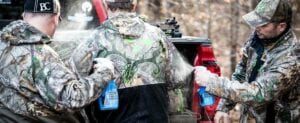 Let’s expand that. A few years ago, what weren’t you doing that you’re doing now?
Let’s expand that. A few years ago, what weren’t you doing that you’re doing now?
A few years ago, I would have my camo and wearing it down the road, in my truck, playing with my dogs, everything else, and then put it away and put it in the washing machine. I just used normal soap and washed it and hang it up in the closet, and then go hunting. Now what I do, I don’t wear that camo anymore. It’s strictly in a Tupperware container. I put the wafers and that little circle thing to put out the scent. I bury those in there and I give it a nice wash before the season starts and put it back in that Tupperware. It never leaves that thing until I’m at my stand ready to get out and go hunting. I get out and basically strip down on the side of the road and put all my gear on.
A lot of guys use Scent Crusher, and there’s a lot of products that help us do that. The biggest thing is, one, no brighteners, no perfumes in your soap, and then put them in tubs and locked bags. Don’t get into them until you’re out of your truck and you’re ready to go hunting, then you put your stuff in. If it’s chilly out, that’s what it is. That helps a lot. There’s a lot of good products out there that can help you minimize scent. The other thing is rubber boots. Leather boots don’t work. You’ve got to wear rubber boots. I love La Crosse. I went to school there, college there. That’s where they’re from. A good muck boot, rubber boots, lacrosse boots. Anything that is scent-free is very important. How about mock scrapes and scent, doe and estrus scent, do you use any of those?
The only estrus scent that I do use, unless I haven’t got a whitetail in bow season, is the elk scent. I’ll use estrus elk. I’ll spray them on the bottom of my boots. That way when I’m walking around calling, and then I can turn back around. If the bull decides to come in, I know that he can smell that. That’s all he’s going to smell. He’s not going to smell me at all, especially when they’re in that zone. They’re looking for elk, they’re looking for cows. For whitetail I always use, I forget what they’re called, but it would be the same thing, doe estrus. It would be from a drip and you hang it from a tree. The deer love it and they’d always come and they’d always scrape their antlers on the top of the tree branches hanging over. I was lucky enough that I always had a tree branch that hung over nice and I’d always scrape the leaves up, and then throw a little dab of doe estrus in there, and it always seemed to work. I set a camera up there and they loved coming into it.
Have you ever misted your elk with doe estrus or cow estrus?
No, I’ve never used that.
That’s a great technique.
I see a lot of people using those, like the estrus bombs or whatever where they just let it go and it sprays the whole air and takes right off.
I’m talking about the perfume where you just pump it, like you were pumping perfume onto yourself. You get those plastic bottles, you mix an ounce of estrus and two ounces of water, so you got three ounces. As you’re setting up, you just mist it. It will go wherever the wind is going. It will carry it a lot farther than you realize. The bull will hit that and he’ll come in. I’ve had a number of bulls come into that in a team calling situation where the caller is behind. He’s misting and I’m misting, and so there’s a lot of cow scent out there. We’ve had multiple bulls come in at the same time.
At the right time of year, nothing is perfect, but you should try that misting technique because it works. One, it helps cover your scent, but it puts a lot of that scent out there that all of a sudden they just get a whiff of it and they’re going, “What’s that?” They know what it is, but now they’re looking for it. They’ll come looking for you. That’s a tip. If you haven’t tried it, try misting. I don’t think I was the first guy to come up with that, but I’ve used it successfully throughout the Rocky Mountains. You can do the same thing with whitetails during the rut. Every once in a while, sitting in a stand, I’ll just hit and I’ll throw some doe estrus out there and it will carry. A couple of tips.
That sounds like a good idea. It even sounds a little bit easier than doing a doe bleed, just throw a little bit of that in the air for them.
You want to get the scent in the air. There isn’t a preponderance of it, but there’s enough that they’ll pick up on it and they’ll start looking. They’ll say, “Where is that coming from?” You can then work them. Tell me about your gear. What bow do you shoot?
I shoot a Mathews Z7. I think I got it when it first came out and I love it. It shoots awesome, it shoots true, it shoots everything. I’ve never switched it up, I’ve never had a problem with it, so I’ve never really seen a reason to switch it up.
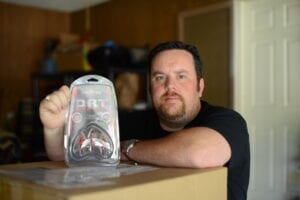 How about your broadheads?
How about your broadheads?
I shoot DirtNap broadheads.
I’m happy with DirtNap. What a great name for a broadhead.
I’ve used a lot of different broadheads and they are my favorite. They have a full warranty, which is sweet. I have to figure out a way of dealing with that because the deer I shot, I did a clean pass-through, which is the first animal I’ve ever had a clean pass-through. The last five animals I’ve shot were at seven and ten yards. DirtNap has just hammered this thing and drove straight through. I had to put another one in because he was a little messed up. When I walked in on him, I jumped him and I had to give him another one. I hit the top of his spine, it bounced through, hit a rib and hit his spine, and it curled the end of it. Those things are so tough, they shoot so true. They shoot just like my field tips, which are awesome.
That’s a good testimony. Tom Addleman is a great guy, makes a great product. If you haven’t tried DirtNap, try them. There’s a lot of good broadheads out there, but they’re in my quiver. If you were starting off hunting whitetails in Canada, what would you tell people right now? “Here’s the first thing you’ve got to do, if you’re going to hunt Canada for whitetails,” what would you tell them?
Depending on the year. If it’s October, November, dress warm. They are awesome animals to hunt. You got to learn them, you got to watch them, you got to set cameras up. You can’t just go into the bush. You can, but that’s getting some good luck if you happen to come across a good buck. In order to hunt whitetail here, it’s just like anywhere else. You got to put the time in. You got to be putting cameras up.
I know a lot of people use outfitters and that’s great, and a lot of people DIY. The good DIY hunters, no matter where they hunt, they observe more than they hunt. I have a good friend, Art Helin, he goes out to the Dakotas. If they’re out there for five days, they’re looking for deer from afar for three days. They’ll spend maybe just one afternoon or one evening on a deer, and they either get it or they don’t. That’s a technique I think a lot of people are missing because they say, “I’m just going to go to the same old stand,” and they might be a quarter-mile from a wonderful Booner buck and they never saw him because they’re in the habits and they’re not observing. If you want to hunt mature whitetail, you’ve got to be observant, you got to be covering the ground, and you got to observe them from afar. You need good glass, get on a hilltop and just sit there from sunup to sundown and see what happens. Your thoughts on that?
That’s exactly right. I feel like you nailed it. Scouting is the biggest thing in hunting by far. If you don’t put the time in it, you’re not going to shoot big deer or big elk or even get on them every single year. You might get lucky the odd year, but if you don’t put the time in, you’re not going to get positive feedback.
Chad, thank you for saying, “I’d love to be on Whitetail Rendezvous.” I love talking to you guys north of the border because you’re fun and are great hunters. It’s just enjoyable. Thank you for being a guest on the show.
Thank you very much for having me.
